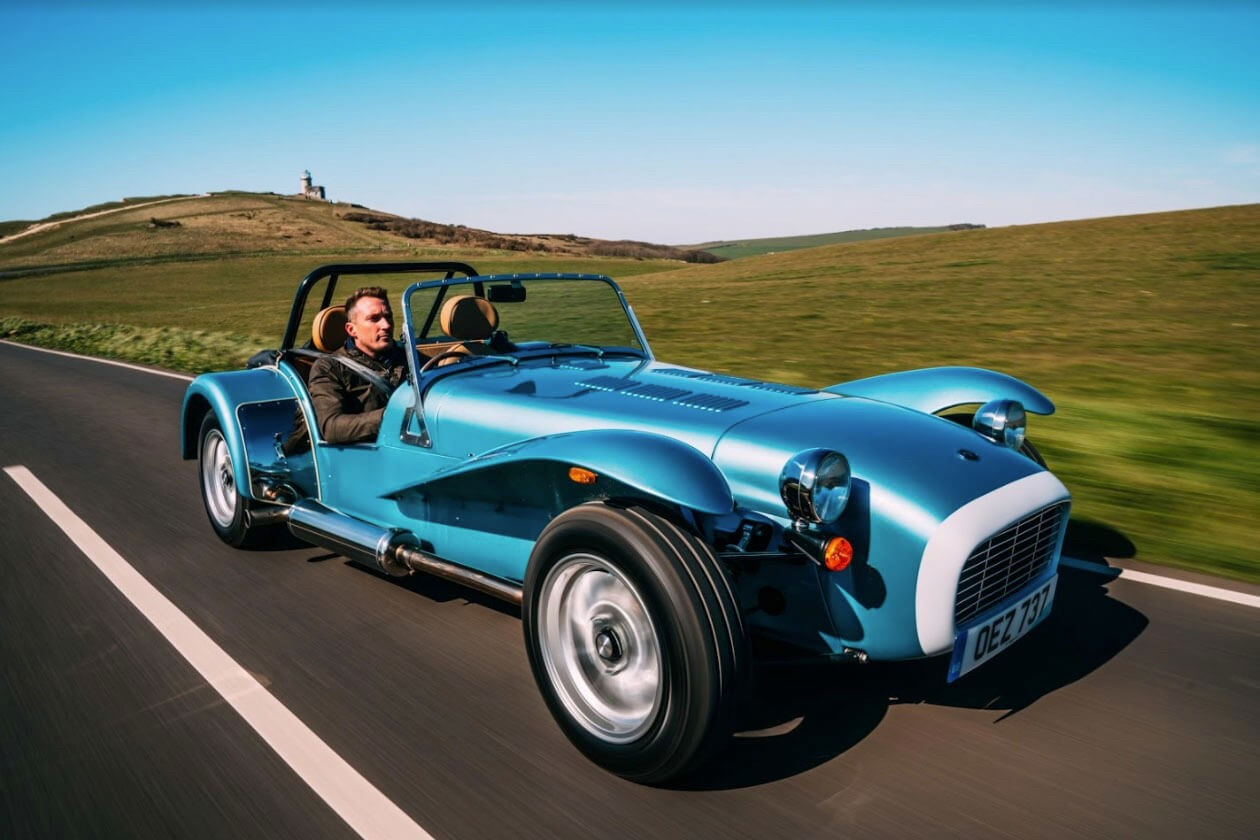Caterham Super Seven 1600: You’ll run out of courage long before it runs out of enthusiasm
It’s fast and fun, but a lot of money for what is essentially a shower, writes Sean O’Grady

The Caterham Super Seven is a bit lethal. I don’t mean by that that it’s too fast. It does a zero to 60 mph sprint in 5 seconds, and onwards to the horizon and 122mph, if your ears, nerves and local traffic regulations will permit it – and it’s not even the fastest Caterham you can get. There’s no such thing as too fast anyway, if you think about it (maybe not for too long). You’ll find the handling pretty safe provided you don’t try any false moves. You’ll run out of courage long before the Caterham runs out of enthusiasm, believe you me.
No, the really lethal thing about the Caterham is that it’s utterly unsuited to the British weather, climate change or not. “Changeable” as the forecasters call it, but when you’re in an open-top Caterham that represents a vicious life-threatening switchback on the road. One minute you’re barrelling down the M1 in Nottinghamshire, bright sunshine, blue skies, nose high to the hub nuts on a juggernaut, grinning at the proof that life can be good; the next moment the skies open and the rains fall heavily heavily down. Spray is all around you and everything goes white-out. Even if my glasses had wipers it wouldn’t have helped. It was such a flash flood people were using their fog lamps, and I could barely detect the vehicle in front. I think it might have been Noah moving some livestock to Felixstowe.
Normally, a convertible driver will just power through a shower, the rain somehow going over their head, but when it goes climate-emergency grade, then you have to get off the motorway and get the hood up. That means slowing down (getting more wet), stilling at the lights (drenched) and trying to find somewhere safe to manoeuvre the roof back on (driver and passenger almost dissolved like Alka-Seltzer by this stage, but with much less fizz). They’ve tried to make getting the cover on the car as simple as they can, but you’re still out long enough for your feet to go all squelchy in your shoes. And, of course, mocked by people with, literally, a roof over their heads. When I got back in I found the indicator switch, a toggle sticking out of the dash rather than a conventional stalk, had gone all floppy and was itself trying to retreat into the dash in order to stay warm. I felt rather vulnerable, I’ll admit. Now I know why the electric hood was invented: to cope with an English summer. I nearly died, and not of laughter.
I’m reminded of the old joke: “Aside from that, Mrs Lincoln, how was the play?”
Actually apart from nearly drowning, and thus representing an unusual sub-category of statistic for fatalities on the roads, it was great fun. If you leave the headlamps on you do get noticed by taller road users, and modern vehicles have all sorts of radar that prevents you getting accidentally trodden on. The engine is loud beyond belief, and above 60mph or so conversation with your companion is impossible (sometimes a bonus). If you’re not careful when you clamber out of the “doors” (plastic flaps that only extend halfway down the minimal bodywork) you’ll scorch your leg on the side-mounted exhaust, and, on a damp day, the engine generates so much heat that you’re basically being poached as you lie prone in your motorised bath tub.
THE SPEC
Caterham Super Seven 1600
Price: £39,655 (as tested, range starts at £29,290)
Engine: 1.6-litre petrol 4-cyl
Power output (bhp): 135
Top speed: 122mph
0 to 60 (seconds): 5.0
Fuel economy (mpg): 57.6
CO2 emissions (g/km): 114
Then again, you see, most things about the Caterham are supposed to be a little spartan. Back in 1957, when the ancestor of today’s model was launched, it was a Lotus, designed by founder and legend Colin Chapman, whose philosophy was “just add lightness”. The distinctive looks of what was originally a build-it-yourself “kit car” haven’t altered much, hence the old-fashioned cuteness. In “1600” form, using a Ford engine usually found lugging much heavier Focuses and Fiestas around, it has a more than adequate weight-to-power ratio (next to nothing divided by 135 brake horsepower), and has a distinctly retro air, harking back to the 1970s, which is the vibe Caterham was looking for.
That said, it has added a few creature comforts these days, such as a new wider shell (for the fuller-framed humans of the 21st century), some nice leather seats and bits of carpet and mohair which make a vain attempt to keep you snug. They’re not true to the spirit of the car, futile and not worth it. A fully built-up Caterham Super Seven 1600 will also set you back the best part of £40,000. It’s a lot to pay for a shower.
Subscribe to Independent Premium to bookmark this article
Want to bookmark your favourite articles and stories to read or reference later? Start your Independent Premium subscription today.

Join our commenting forum
Join thought-provoking conversations, follow other Independent readers and see their replies